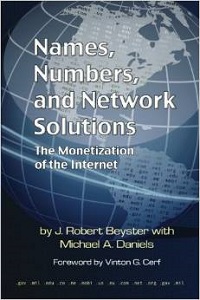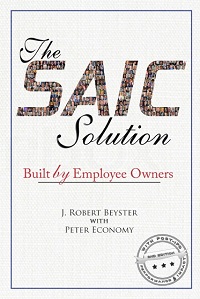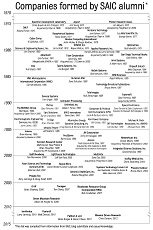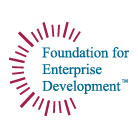I have enjoyed reading your responses to my questions on this blog. I am still not overwhelmed by the title suggestions. Keep thinking! I have enjoyed comments from those of you who feel that your lives were changed in some way as a result of your SAIC experience. Therefore, this week’s question is this: At what point did you come to the realization that working at SAIC was something very special? What event brought you to that realization, and how did it impact your career and your life?
Click on the comments link to share your thoughts.
- Bob
Here are my responses to previous weeks’ comments:
Donna Cunningham (Week 16): I agree, no question about it. CHCS will definitely be discussed in the book.
Kevin Collins (Week 16): I’m glad to hear about your enthusiasm for SAIC, despite the fact that it sounds like you were not a participant in the SAIC stock program.
Charlie Stevens (Week 16): Establishing the stock bonus program was a major accomplishment, and you had a lot to do with it. I believe it would have been worthwhile exploring the potential for an ESOP buyout as an S corporation — that may have helped satisfy SAIC’s cash needs for a long time.
Regina Sebastian (Week 16): Yes, I think CMM was a very important set of processes and contributed to our successful bidding and delivery in the software area. Some customers insisted on at least Level 3 or we wouldn’t get the contract. Please explain how the CMM criteria differs from A20 — it slips my mind nowadays?
Kevin Winstead (Week 15): Well stated. We will look into incorporating these thoughts into the book. Your title suggestion will go into the hopper.





My life may not have been changed but the way I view management has changed from interaction with Larry Kull in early years of SAI. To quote: “If you are doing well with your Operation and don’t hear from me – keep on going – I won’t interfere”.
Dr. Beyster,
I was part of the original AMSEC management that was acquired by SAIC in 1987. I would think the story of a $17M technical services company, being acquired by a large R&D and technology firm, and growing to $500M company under that unique culture, would be one worth telling.
The impact of the EO culture on me personally, as I made my journey from an engineer in AMSEC to a Group Manager and eventually into SAIC proper is immeasurable. It was an incredible 20 year journey. If it would be of value to you, I would be glad to share with you any of those thoughts on that story.
As I venture out to start my own company, the lessons I learned in those 20 years will surely serve me well. Thank you.
I realized SAIC was a very special place to work from the first day of my employment back in 1989. As I walked down the hallway to my office on that first day I couldn’t help but notice the number of “Dr.” titles on the name tags outside the office doors. As I met and got to know my coworkers and managers I noticed that on the bookshelfs were many academically oriented text books. In my previous job reading a text book would be grounds for disciplinary action. I was extremely impressed by the academic culture that is encouraged and practiced at SAIC to this day. This initial impression had a huge impact on me and I then decided to pursue higher education and soon after received a MS degree in Information Systems Management. Thanks to SAIC’s tuition reimbursement program I was able to achieve my educational goals. I’ll never forget the words of my group manager at the time – “Pete, if you take a class and pass it, I will make sure it’s payed for.”
Dr. Beyster,
The technical environment that you fostered at SAIC really made it compelling to self-actualize (to borrow a popular organizational theme in those days) one’s technical capabilities. Thank you.
For me, the competitive IR&D environment gave technical types an opportunity to express themselves. The IR&D feedback system (Clint Kelly) was invaluable. Whether an IR&D was approved or not, many ideas went on to become great technical solutions for customers.
Meetings Week was another such forum. Being invited to present a project, an approach, a capability, or a solution was a powerful event. Later on, I fully appreciated the dialog facilitated (and feedback presented and received) during the review of critical win/loss proposals. The lessons learned were like a clear picture versus a bunch of written words. Finally, the pre-board dinners really offered an opportunity for managers to co-mingle on a social note and offered other opportunities to deepen the overall organizational understanding.
Your insight at the Management Council was refreshing and really helped the organization to focus.
Thanks you
Andre LeCault
Some random thoughts:
Book Title: Building the Most Successful Employee-Owned Company in U.S. History (or some variant of that theme). On the back outside cover display a chart showing two things: 1) the growth in the value of $1000 in SAIC stock in 1969 to the time you left and 2) the number of employees in 1969 to the same end-point. If you can estimate the number of employees you made into millionaires, add that too.
The Special Sauce: It was the structure that allowed the people to flourish. This included all the independent P&L centers that were encouraged to do anything they wanted as long as it was ethical and profitable; the acceptance of people so bright and so competitive they would be considered troublemakers almost everywhere else; the willingess to let exceptional technical people become productive senior technical staff and not miserable junior division managers; and the breadth and depth of the stock programs, especially the CODA and the wide dispersion of stock bonuses and stock options.
Employee-Ownership: The part of employee-ownership that was the most important to me was that any idea, business plan, client relationship, etc. was given a fair hearing no matter where it originated and no matter where it was going. If it made sense there was a good chance it would be implemented and an even better chance that the individual who came up with the idea would be in charge of doing the implementing. That kind of business model is associated with universities and start-ups, not multi-billion dollar operations.
The Stock: A compound annual growth rate of 20%+ per year with very little variance over any period of years is not only a powerful inducement to stay with the company, it’s an unassailable indicator of the long-term success of the business plan. The fact that the stock was very broadly distributed among the employees and not largely retained by the very top managers was incredibly important. It meant that we were working for the company we all owned, not the company you mostly owned.
The Biggest Complaints from Down in the Trenches: What did all that senior administrative and marketing staff at the group level and higher actually do? How are we supposed to write that big proposal on that tiny amount of B&P? Were the contracts reps told to be adversarial to the technical staff and uncooperative with the clients or did that just happen naturally? A chapter on what we complained about would provide a useful counterpoint to the idea that everything was straightline success and would be among the most interesting parts of the book.
What People Would Like to Read in the Book: The big wins made the company big, they didn’t make it interesting. The interesting stuff (besides the complaints and the secret sauce) would include the real stories behind the divisions that bid against each other, winning the Americas Cup, the interminable arguments over the stock price, the earlier controversies about going public, brilliant technologies invented or first applied and what they accomplished, and how you kept order among sectors and groups that were all trying to do everything for everyone at the same time.
You should also talk about your opinion of going public and the future of the company. For those of us who experienced all the other stuff, that’s the part we want to read about.
Harry Chernoff
SAIC 1979-2003
Bob:
Here are a couple of additional thoughts for a book title:
Win-Win — Bob Beyster and Employee Ownership at SAIC
Win-Win — Empowering the entrepreneurs that built Science Applications
Your prospective book subject is less grandiose than mine – it hasn’t a title other than “THE COLD WAR -an insider’s view”, and it is far from complete, but I have already written parts of 18 chapters.
Nice to know that you are not just sitting in a rocking chair in an old folks home, or just lounging on deck of your boat. I, too, can’t give up entirely on the “work ethic” thing, so good luck.
Unfortunately, since I did not work directly for SAIC, I can’t contribute to your manuscript. But I do remember more than once entering a DASA or DNA office to sell an idea to meet you comming out, having again beat me to the punch. For a long while SAI prospered very largely because of Bob Beyster’ ability to sell programs and recruit the best scientists. “Science” in the company name is well deserved.
Go for it!
Hal Brode
Another Title idea:
“The SAIC Notebook: A Success Story”
One of my favorite things about working there was seeing your constant note taking in those spiral notebooks. (You must have filled a thousand of them.) Might as well name the book after them.
Take care,
Mike
Dr. B,
With regard to CMM and the A-20 ( now SG-20), they are different in that the CMM processes were a tailorable way/methodology to develop quality Software and Systems . The A-20 ( SG-20 ) is a company review process to assess and quantify the risk of a program/project from inception through its execution.
Best Regards,
Regina
When I told my Father that I was developing software to extract nuclear reactor containment water analyze it then send it back. I believe his response was are you NUTS! That’s when I new I was doing something really meaningful.